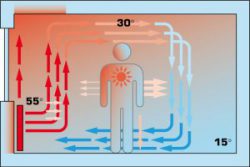Today, every 2nd heating system used in new construction or renovation works via thermal radiation. According to experts, this type of heating should be healthier for residents. The reason for this is the lack of air circulation and thus the lack of dust swirling in the room.
Why this is so and how the principle of “radiant heat” works, you will learn in this article.
1. not the air is heated but the matter
Since time immemorial are known heaters that heat via convection heat. In the process, the surrounding air is heated. The situation is different with heaters that operate via radiant heat.
In most cases, not only a small area, such as the radiator, is heated, but a large area.
With the operation of the system, surfaces evenly release heat to the surrounding cooler matter (components, furniture, people, …) in the room. The air remains unaffected by this for the time being.
This is how physics sees it
In physics, radiant heat is the transfer of thermal energy in the form of electromagnetic waves in the non-visible mid-infrared range.
Our visible light also belongs to the electromagnetic waves and has wavelengths of approximately 400 nm – 700 nm (1 nm = 1 billionth of a meter). Directly behind it is thermal radiation with wavelengths from 700 nm to 1,000,000 nm. You can’t see this, you can only feel it, and it’s in the form of heat.
In addition, it has been proven that the proportion of radiant heat increases with the size of the heating surface. If, for example, a room is heated with underfloor heating, the proportion of radiant and convection heat is approx. 50 % each. If other surfaces, such as walls and/or ceiling, are heated, the proportion of radiant heat increases to up to 95%.
Air circulation is minimal
To the delight of many allergy and asthma sufferers, radiant heat creates almost no air circulation and dust swirling in the room. The reason is that almost exclusively the matter is heated, and not the air. For you, the indoor climate feels even and pleasant.
 With convection heating the situation is different. This heats the air surrounding the heater, which moves upward to the ceiling as the temperature rises.
With convection heating the situation is different. This heats the air surrounding the heater, which moves upward to the ceiling as the temperature rises.
From there, as the air cools, it sinks back down to the floor, where it is reheated. We are familiar with this circulation process, for example, when using radiators.
2. nature proves that radiant heat works
In many everyday situations, you can feel that radiant heat works. For example, if you stay near a tile stove or campfire. A far more intense example is the sun.
The sun as the most powerful radiant heat
Although it can show sub-zero temperatures outside, it feels pleasantly warm when the sun is shining. However, if a cloud moves in front of the sun in the next moment, it can become really unpleasant.
Even if the air temperature is measurably the same, the human body perceives the temperature in the shade as significantly cooler.
This mechanism is proof that radiant heat works.
Conclusion: Radiant heat is pleasant and healthy!
Radiant heat is an attractive alternative to convection heat, especially with regard to the absence of dust whirling up. Since time immemorial, man has known this form of heat transfer already through the sun. So it is the most natural way to transport heat.
Today, many heating manufacturers already offer heating systems that operate via radiant heat. Very common here are panel heating of any kind. These can be installed not only on the floor, but also on walls and/or ceilings.
Our panel heating also works via radiant heat and is energy efficient. If you also want to benefit from the advantages of radiant heat, click here.
Yes, I would like to benefit from the advantages of radiant heat.
Photo: JenkoAtaman – fotolia.com



